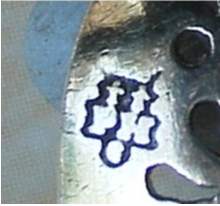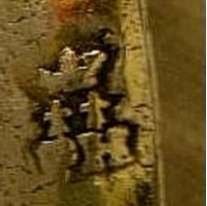by David
McKinley
(click on photos to enlarge image)
A REAPPRAISAL OF THE MARKS USED IN THE HARACHE WORKSHOP
In November 1681 fire swept through Goldsmiths’ Hall in
London destroying much which would have been of great interest
and importance to historians and collectors alike. One of our
greatest losses from the point of view of those interested in
identifying the makers of silver plate of this period is the
loss of the records of makers' marks. Although a new mark plate
was raised in 1682 (according to Chaffers the 1675 plate
survived) (note 1) and the makers
struck their marks on this, the mark book in which their names
would have been recorded has not survived.
The marks struck on this new plate are in nine vertical columns
and about one third of the way down the second column is a mark
which has been attributed to Pierre Harache I whose Britannia
standard mark, registered in 1697 and positively identified by
his name, has certain motifs incorporated in it which are
similar to those appearing in the 1682 mark which has the
letters P H to identify its maker.
These motifs are not peculiar to the Harache family, although
they were also used in the mark registered in 1698 by Pierre
Harache II, but can be seen in an, as yet, unidentified mark
which displays the letters L B to identify its maker. (New
Jackson p146). However I believe, as others before me have
believed, that there can be no doubt that the P H mark on the
1682 plate is that of an Harache but which one?
The only Pierre Harache known to have gained his freedom of the
Goldsmiths’ Company at this early date, which he did on 21st
July 1682, and therefore eligible to register his mark on the
1682 mark plate was the man, born in Rouen in 1639, who has been
identified as Pierre Harache I and reason would seem to dictate
therefore that the mark in question was his.
However new evidence has now come to light that must cast some
doubt on this. An unregistered sterling maker’s mark has been
discovered on items of small work of the early 18th century
(note 2) which so closely resembles
one of the four Britannia marks of Pierre Harache II, born in
Rouen in 1653 but only distantly related to his namesake above,
that there can be no doubt that it was his Fig I. Similarly an
unregistered sterling maker’s mark has been discovered on an
item of small work of the same approximate date
(note 3) which resembles the Britannia mark of Pierre
Harache I much more closely than does the mark appearing on the
1682 plate and it is difficult to see how it can be other than
his Fig II.
 |
 |
Fig I: Sterling maker's mark
of Peter Harache II
|
Fig II: Sterling maker's mark
of Peter Harache I
|
 |
 |
 |
Sterling maker's mark
of Peter Harache II
|
|
Snuff spoon with mark of Peter Harache II
|
In fact the mark on the 1682 plate is very like another of the
four marks registered by Pierre Harache II but its position on
the plate suggests that it was struck either when the plate was
raised or soon after and cannot therefore be that of Pierre
Harache II who didn’t arrive in England until 1686.
A possible explanation is that there was a third Pierre Harache
and that this mysterious mark was his. Both Heal
(note 4) and Grimwade (note 5)
hinted at the possibility that there was a third Pierre Harache
but neither could identify him. Recent research has however
brought to light enough evidence to show that there must have
been a third Harache bearing the name Pierre although he still
remains a shadowy figure.
This research has exposed the fact that the Haraches worked as a
Company under the title "Pet: harache &c goldsmiths" and a bill
made out to St. George Esq. of Dublin in 1703 clearly shows,
from the handwriting, that the writer of this bill was neither
Pierre Harache I nor Pierre Harache II. Further it was not made
out by Stephen Hobbema, Pierre Harache I’s son in law, who kept
the Company accounts and receipted it.
Christopher Hartop, In writing the introduction to "Beyond the
Border" has made clear that in most workshops more than one
maker would have been employed in the production of an item of
large work and that the marks appearing on such pieces need not
necessarily therefore relate that piece to any one of these
makers (note 6). The marks must, in
fact, be looked on as ‘workshop marks’.
The marks on small work on the other hand almost certainly
relate the piece to the maker as only one man would have been
involved in its production. This being the case the two small
workers’ marks mentioned above must be accepted as those of
Pierre Harache II and Pierre Harache I respectively whereas the
three large workers’ marks under review here may not relate to
either specifically.
If the sterling maker’s mark struck on the 1682 mark plate was a
workshop mark and was related to a third Pierre Harache rather
than to either of his namesakes why do some of the registered
marks of Pierre Harache II resemble it so closely?
A possible explanation is that Pierre Harache III had retired
from actively practicing his craft by 1698 when Pierre Harache
II registered his marks ( he is known to have been dealing with
Hoares’ Bank in second hand silver after 1697) and Pierre
Harache II, who had not until then had a mark of his own,
adopted the main motifs of the workshop mark as his, Pierre
Harache I having already registered his own mark the year before.
Peter Harache III was probably the first of the three to arrive
in this country and is likely to have been responsible for setting up
the workshop in which all three worked under the title ‘Pet:
harache &c goldsmiths’ (note 7).
This explains a mystery which, until now, has attached to Peter
Harache I. He arrived in this country in October 1681 with very
little with which to earn his living (a letter from the Treasury
to Customs Officials dated 20th October 1681 exempting him from
Customs Duty mentions nothing but 238 ounces of mixed old and
new plate) (note 8). He was not
endenizened until June 1682 and not made free of the Goldsmiths’
Company until 21st July of that year, the date on which the new
letter of the year came into use (note 9),
yet the earliest example of the mark attributed to him is on
candlesticks struck with that letter!
A pen and ink drawing at Goldsmiths’ Hall of a 17th century
silversmith’s workshop shows five men all engaged in different
tasks and an early print of such a workshop shows no fewer than
fourteen men and a boy variously engaged at furnaces, a lathe, a
wire stretcher, a snarling iron and several other benches. This
Harache certainly did not have the wherewithal to set up his own
workshop of this sort in the time available to him by 1682 and
must therefore have made use of one already established so who
was responsible for this workshop?
The first member of the Harache family to come to England was
Peter Harache I’s brother Nicolas who was here in 1668
(note 10) and he could have set up a
workshop although there is no evidence that he was a goldsmith.
The evidence is, however, that Nicolas died circa 1677 and
whatever trade he plied it was not carried on by his widow since
she returned to France in that year. It would seem therefore
that no workshop could have survived from that time.
The next family member to flee France and settle in London was
Peter Harache I’s sister Madeleinne whose husband Edouard
Hobbema presented his témoignage (note 11)
on 18th July 1675 (note 12). Edward
was a master goldsmith who had been working in Paris before
migrating to England, probably in the workshop which Pierre
Harache I had used when in Paris in 1668
(note 13). It seems that this is the most likely date
for the setting up of any workshop in which a family member
could have worked on arrival in this country.
No indication has been found that Pierre Harache III came to
this country from Rouen and the most likely scenario is that he
arrived with the Hobbema family from Paris. If he was
responsible for setting up the Harache workshop and for
registering the mark on the 1682 mark plate which relates to it
then the features of the above hypothesis, which explains the
form taken by Peter Harache II’s mark, falls into place. However
this leaves open a mystery; according to the records available
from the period the evidence is that the Goldsmiths’ Company
would not have accepted the registration of a mark by a non
freeman and, as stated above, apparently the first Peter Harache
to gain the freedom of the Goldsmiths’ Company of London was
Peter Harache I! (note 14) If this
sterling maker’s mark, which is struck on the 1682 mark plate,
is that of Peter Harache I, as has been assumed until now, then
whose workshop was he working in when he entered it and what
form did that workshop’s mark take?
When he entered his Britannia standard mark in 1697 he gave his
address as Suffolk Street and the belief has been held that this
was the site of the workshop. However there is no reference to a
Peter Harache in the rate books for Great Suffolk Street until
1686 so if this was the site of the workshop it must have been
in the occupancy of someone else when Peter Harache I became
free of the Goldsmiths’ Company in 1682.
The denouement is that there must now be some doubt about the
attribution of the sterling maker’s mark, struck on the 1682
mark plate, to Peter Harache I. Further it must now be accepted
that more than one workman would have been involved in the
production of large plate coming out of the Harache workshop and
that therefore none can be attributed to any particular Harache.
A registered mark appearing on an item of plate must indicate
that the man who registered that mark was primarily responsible
for that plate but that to all intents and purposes the mark is
a workshop mark.
NB: It is now known that Peter Harache I died in 1712 and that
Peter Harache II returned to France where he died in 1718. The
death of a Pierre Harache in 1700, as recorded by Heal, was
probably that of Peter Harache II’s son who was born in 1696 and
about whom nothing more is recorded.

|

|
two images of typical
Harache work
|
David McKinley
- 2009 -
David McKinley devotes much of his time to researching
the history of silversmithing in England with particular
reference to hallmarking at the London office. He writes
for both The Silver Spoon Club of Great Britain and The
Silver Society.
|
|
|
 ASSOCIATION OF SMALL COLLECTORS OF ANTIQUE SILVER
ASSOCIATION OF SMALL COLLECTORS OF ANTIQUE SILVER





